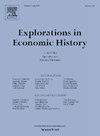富人有多富?基于经验的工业化前财富基础分类法
IF 1.7
1区 历史学
Q1 ECONOMICS
引用次数: 0
摘要
本文利用从公元前 330 年的希腊到 1940 年的墨西哥的 53 张社会表格,估算了工业化前社会中收入最高的 1 % 人口所占的比例和收入水平。收入最高的 1%占社会收入的比例从 10%左右到 40%以上不等,而且并不总是与估计的基尼系数和不平等提取率同步变动。我根据与顶级阶层相关的社会阶层和资产类型(土地、政府控制权、商业资本、公民权)以及与贫困相关的资产缺乏情况,对前工业社会进行了分类。本文章由计算机程序翻译,如有差异,请以英文原文为准。
How rich were the rich? An empirically-based taxonomy of pre-industrial bases of wealth
The paper uses fifty-three social tables, ranging from Greece in 330 BCE to Mexico in 1940 to estimate the share and level of income of the top 1 % in pre-industrial societies. The share of the top 1 % covers a vast range from around 10 % to more than 40 % of society's income and does not always move together with the estimated Gini coefficient and the Inequality Extraction Ratio. I provide a taxonomy of pre-industrial societies based on the social class and type of assets (land, control of government, merchant capital, citizenship) that are associated with the top classes as well as lack of assets associated with poverty.
求助全文
通过发布文献求助,成功后即可免费获取论文全文。
去求助
来源期刊

Explorations in Economic History
Multiple-
CiteScore
2.50
自引率
8.70%
发文量
27
期刊介绍:
Explorations in Economic History provides broad coverage of the application of economic analysis to historical episodes. The journal has a tradition of innovative applications of theory and quantitative techniques, and it explores all aspects of economic change, all historical periods, all geographical locations, and all political and social systems. The journal includes papers by economists, economic historians, demographers, geographers, and sociologists. Explorations in Economic History is the only journal where you will find "Essays in Exploration." This unique department alerts economic historians to the potential in a new area of research, surveying the recent literature and then identifying the most promising issues to pursue.
 求助内容:
求助内容: 应助结果提醒方式:
应助结果提醒方式:


